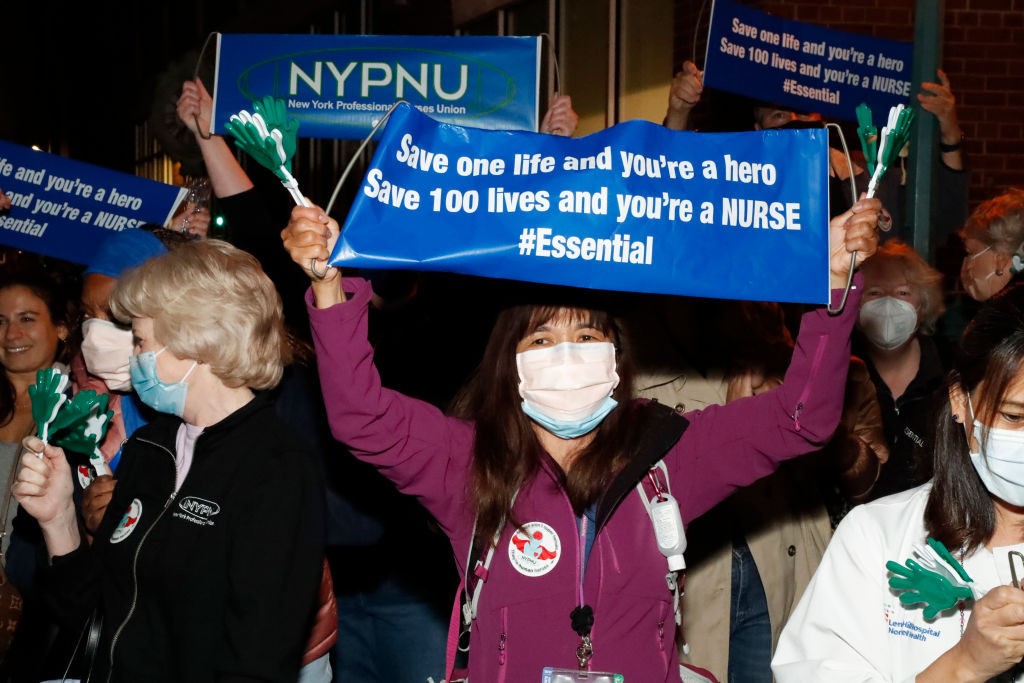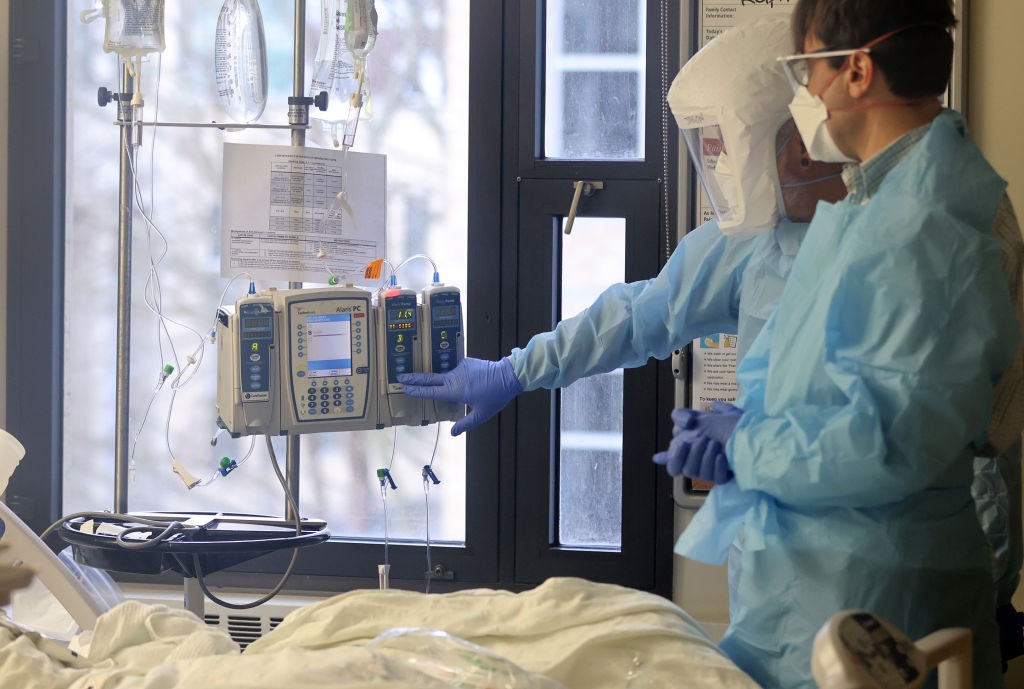Results 1 to 2 of 2
Thread Information
Users Browsing this Thread
There are currently 1 users browsing this thread. (0 members and 1 guests)
-
01-25-2022, 11:08 AM #1
Healthcare Executives Import 1,000 Nurses a Month for American Jobs
Healthcare Executives Import 1,000 Nurses a Month for American Jobs
by NEIL MUNRO 25 Jan 2022
U.S. hospitals and staffing companies are extracting roughly 1,000 nurses each month from poor countries instead of recruiting and training Americans for the nursing jobs, say media reports.
The New York Times newspaper described the extraction migration process on January 24:
About 1,000 nurses are arriving in the United States each month from African nations, the Philippines and the Caribbean, said Sinead Carbery, president of O’Grady Peyton International, an international recruiting firm. While the United States has long drawn nurses from abroad, she said demand from American health care facilities is the highest she’s seen in three decades. There are an estimated 10,000 foreign nurses with U.S. job offers on waiting lists for interviews at American embassies around the world for the required visas.
This medical migration of nurses and doctors “ultimately is about the money” for the medical sector, said Kevin Lynn, founder of Doctors Without Jobs.
The New York Times article admitted the central role of economics in the healthcare migration with a headline saying: “Rich Countries Lure Health Workers From Low-Income Nations to Fight Shortages.” That’s a sharp break from the newspaper’s usual migration coverage, which overwhelmingly focussed on migrant family dramas rather than economic impacts.
“The medical establishment, just like any other corporation, is looking for efficiency — faster, cheaper,” said Lynn, who campaigns for American medical graduates who lose vital training slots in government-funded residency programs to imported foreign medical graduates.

The New York Professional Nurses Union hosts a light projection and evening cheer for nurses at Lenox Hill Hospital on October 28, 2021 in New York City. (Astrid Stawiarz/Getty Images for Unbendable Media)
But the employers’ desire for imported foreign doctors and nurses is also a labor-rights and healthcare quality issue, he added. “It’s not just about them being less expensive — it’s about them being more pliable because they’re chained [by their conditional visa] to the employer.” Without citizenship that allows them to live and work in the United States, the imported nurses, doctors, and therapists cannot argue against cost-cutting policies by the executives who have the legal power to send them home.
The failure to train and hire Americans for nursing and doctor jobs also leaves fewer nurses and doctors for poor people in the developing countries, such as Zambia, according to the New York Times:
“People are leaving constantly,” said Ms. Mwape, whose inbox is flooded with emails from recruiters letting her know how quickly she can get a visa to the United States. The net effect, she said, “is that we are handicapped.”
“It is the most-skilled nurses that we lose and you can’t replace them,” Ms. [nurse Lillian] Mwape said. “Now in the I.C.U. we might have four or five trained critical-care nurses, where we should have 20. The rest are general nurses, and they can’t handle the burden of Covid.”
Dr. Brian Sampa, a general practitioner in Lusaka, recently began the language testing that is the first step to emigrate to the United Kingdom.
He is the head of a doctor’s union and vividly aware of how valuable physicians are in Zambia. There are fewer than 2,000 doctors working in the public sector — on which the vast majority of people are reliant — and 5,000 doctors in the entire country, he said. That works out to one doctor per 12,000 people; the W.H.O. recommends a minimum of one per 1,000.
This government-enabled, employee-run extraction process ensures that both the people in developing countries and Americans lose quality care, and many Americans lose healthcare careers, Lynn added. “Wealthy Americans probably aren’t seeing this [replacement], but people on your typical bronze and silver plans are, and certainly the people who don’t have access to health insurance are seeing this,” he added.
The coronavirus crash has highlighted the hidden process of healthcare extraction.
Business groups and their immigration lawyers have long argued for rules that would allow them to import an unlimited number of low-wage healthcare employees. “The [annual] cap [of 85,000 work visas] should be repealed altogether for the healthcare sector, as it is for the university and non-profit sector already,” advocate Daniel Griswold told the House committee on small business in 2019. Griswold is a director at the Koch-funded Mercatus Center in Arlington, VA. The demands got louder during the coronavirus crash but went nowhere while President Donald Trump was in office.
President Joe Biden’s deputies are now opening more doorways for employers to hire foreign white-collar workers — despite rising public concerns about the loss of many Fortune 500 jobs to corporate-recruited H-1B visa workers. Already, roughly 1.5 million U.S. jobs are held by visa workers instead of by Americans, so forcing down wages for many white-collar jobs.

Nurse Jason Doff, wearing a PAPR, and Dr. James Darnton (R) check on a patient in the acute care COVID-19 unit at Harborview Medical Center on January 21, 2022 in Seattle, Washington. (Karen Ducey/Getty Images)
In November 2021, the hospital sector asked President Joe Biden’s deputies to accelerate the visa review process for foreign nurses. Since 2011, the Department of State’s embassy in Manila has annually processed roughly 30,000 requests from Filipino nurses and healthcare aides to get work permits or green cards prior to taking U.S. healthcare jobs. Under Trump’s curbs, the process had dropped to 8,982 requests in 2020, so opening up many jobs at high wages for American nurses.
Many Americans have quit the medical sector in 2020 and 2021 after many months of fighting the coronavirus diseases. The resulting workforce gaps have been partly filled by American professionals who had retired before the disease, by military doctors, and by contract nurses who travel from place to place.
Employers are also being forced to pay higher wages to American nurses who keep working even as roughly 20 percent of their peers quit the sector.
The Washington Post reported the employers’ complaints about supposed price “gouging” on December 6:
The continued pandemic; an aging, burned-out and retiring nurse workforce; the return of hospital services that were shut down last year; and a shortage of foreign recruits and nursing students have combined to make travel nursing one of the most critical and sensitive issues in health care.
“Of all the things that keep CEOs of hospitals up at night, this is the key one,” said Chip Kahn, president and chief executive of the Federation of American Hospitals, which represents about 1,000 for-profit facilities.
In contrast, nursing groups are blaming the employers for not recruiting, hiring, and training enough young Americans, according to the Post’s article:
“This current staffing crisis is one of the hospital industry’s making,” Deborah Burger, president of National Nurses United, said in a written statement. “They need to take a long hard look at how their treatment of permanent staff and exploitation of the nursing ethos has inevitably led to this unsustainable model of staffing hospitals.”
Hospitals must train more people for nursing jobs, Professor Joanne Spetz at the University of California, San Francisco, told the Marketplace.org radio show in September 2021. “That really is then shifting this emergency [coronavirus response] thing into the long-term investment philosophy … and that’s really where we’re going to have to go.”
There are millions of Americans who can be trained and paid to do healthcare jobs. Total nonfarm employment in the U.S. is now just under 149 million. In February 2019, there were 152.5 million people employed.
Healthcare Executives Import 1,000 Nurses a Month for American Jobs (breitbart.com)Join our efforts to Secure America's Borders and End Illegal Immigration by Joining ALIPAC's E-Mail Alerts network (CLICK HERE)
-
01-27-2022, 11:02 AM #2
Fire legal U.S. citizens for not taking the poison jab and import foreign labor.
What a stab in the back to the American people.
This is outrages.ILLEGAL ALIENS HAVE "BROKEN" OUR IMMIGRATION SYSTEM
DO NOT REWARD THEM - DEPORT THEM ALL
Similar Threads
-
Koch Network Begs Joe Biden to Import More Foreign Workers to Take U.S. Jobs
By Scott-in-FL in forum General DiscussionReplies: 0Last Post: 04-26-2021, 10:55 PM -
12,000 Minn. Nurses Launch 1-Day Walkout (Natl Nurses Union)
By Texas2step in forum Other Topics News and IssuesReplies: 3Last Post: 06-10-2010, 08:21 PM -
Stimulus adds 3.6 M jobs, feds import 3.2 M foreign workers
By cjbl2929 in forum General DiscussionReplies: 5Last Post: 02-17-2009, 05:40 PM -
Import Workers Or Export Jobs?
By Brian503a in forum illegal immigration News Stories & ReportsReplies: 2Last Post: 07-29-2005, 08:35 PM


 LinkBack URL
LinkBack URL About LinkBacks
About LinkBacks




 Reply With Quote
Reply With Quote


New poll shows rising Latino support for border wall, mass...
04-18-2024, 06:50 PM in General Discussion